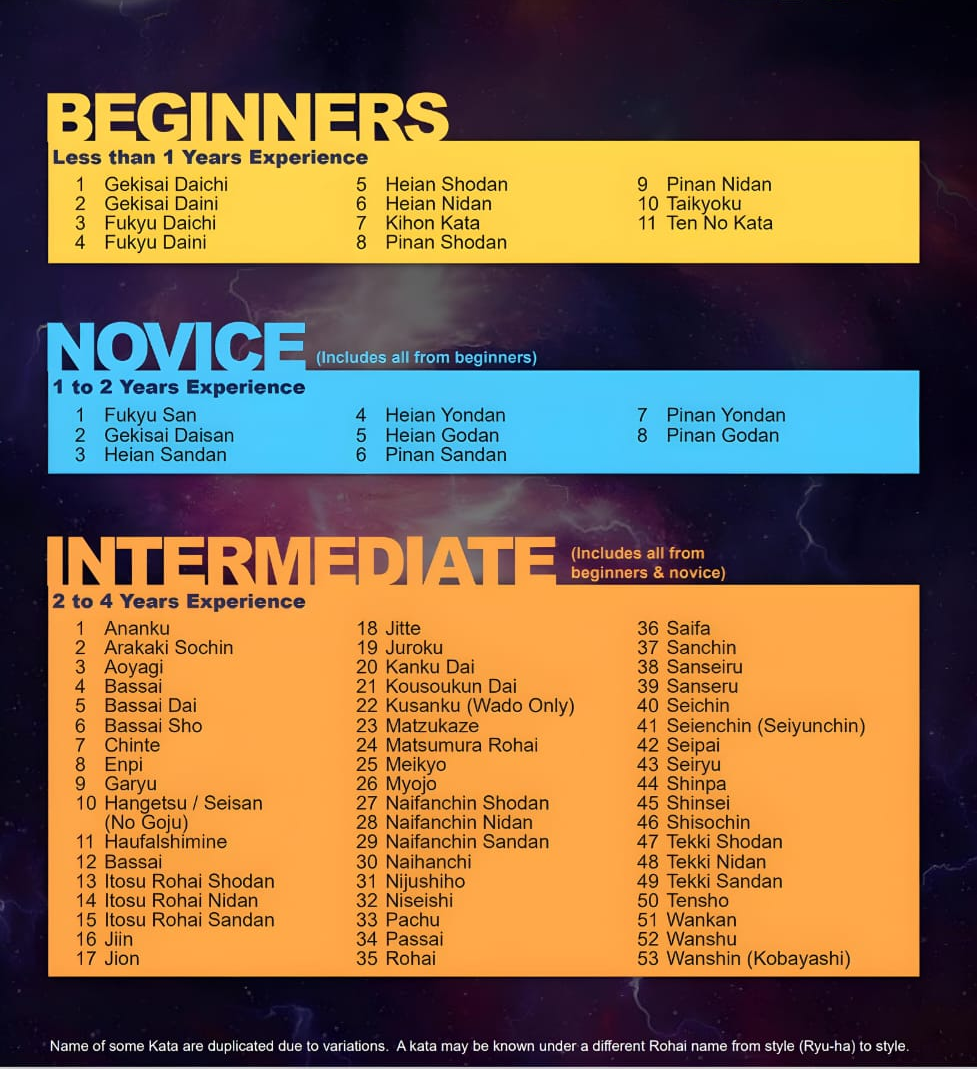Does a competitor need a Martial Arts membership in order to compete at the Silverado Cup?
- No, a competitor won't require to be member of any Karate organization in order to compete.
What are the Silverado Cup Tournament rules will be?
Will an AAU Karate Kumite equipment will be Ok to be used at the Silverado Cup?
- Yes, The AAU Karate Kumite equipment (headgear, protective mitts, shin and foot pads, cups for boys and mouth guards) will be good to be used at the Silverado Cup. Colors: Red, Blue or White are recommended.
Registration
- Can I confirm my registration?
Yes. You can confirm your registration online by going to www.silveradocup.com and selecting “confirm registrations” on the main page. Enter your infomation on the requested. If you have registered online, you will receive an “order confirmation” via email in addition to being taken to a confirmation screen at the conclusion of the registration process. If you do not receive the confirmation email, please check your spam filter.
If you completed the paper application and mailed your registration, it will take approximately 1 to 2 business days for your registration to appear online using the website. Because of the volume of paper registrations, we cannot confirm your registration any sooner than it would appear online.
- What if I confirm my registration and it is incorrect?
If the registration appears to be incorrect online, simply contact us make changes to your registration.
- What if I make a mistake during registration, do I have to pay a change fee?
No, simply contact us make changes to your registration.
- What are the skill levels and how do I know which skill level I should compete in?
The skill levels are to help keep the competition a level playing field for all competitors. The Silverado Cup is committed to giving every athlete the opportunity for success in the ring, so some changes have been made to the skill level descriptions. Here is a description of the skill levels:
- Beginner – 8thkyu and under/Less than 1 year of training
- Novice – 7thkyu-5th kyu/1-2 years of training
- Intermediate – 4thkyu-2nd kyu/2-4 years of training
- Advanced - 1stkyu and higher/4 years or more of training
- Elite – Divisions/Recommended rank of 1stDan or higher and 5+ years of training
- All brown belts must compete in intermediate or higher divisions
- All black belts must compete in advanced or higher divisions
- Athletes who participate in a beginner, novice, or intermediate division must compete in that skill level for all divisions
- An athlete who participates in an elite division may compete in an advanced division in another category (Exp: Athletes may compete in Elite Kumite and Advanced Kata, but may not compete in Elite Kumite and Advanced Kumite)
- Athletes who compete in Elite Kata may not compete in any other Kata division
- Athletes who medal in any skill level must move up to the next higher skill level the following year (Exp: An athlete who medaled in a Novice category in 2023 must compete in the Intermediate or higher category in 2024)
- The ultimate placement of athletes in the correct skill level is the responsibility of both the athlete and their coach/instructor. We rely on the integrity of all of our participants to ensure for the safest and most fair competition. Should an athlete be found to purposefully misrepresent their skill level for the purpose of competitive advantage, should be desquilified.
If I have been training for 2 years but have a brown belt, I have to compete as an intermediate?
Yes, all brown belts must compete in intermediate or higher divisions.
- Can I compete in Elite and Advanced Divisions?
That depends, Elite is a separate skill level division available to Advanced competitors, therefore competitors may compete in Advanced or Elite per event category (Kata or Kumite). For example, an athlete may compete in Elite Kata and Advanced Kumite or Elite Kumite and Advanced Kata but CANNOT compete in both Advanced Kata and Elite Kata.
- If I register for Elite Kumite, do I have to register for Elite Kata?
No, Kata and Kumite are separate events and you CAN register for Elite in one event and Advanced in the other. You CANNOT compete in Advanced and Elite in the SAME event.
- What if I just want to watch the tournament?
Yes, You are welcome to come and watch the tournament. The tickets may be purchased at the venue. The price list is below:
- $10 per person
- $25 for a family
- Children under 6 are free
How can I be a volunteer?
All volunteers are encouraged to register in advance online here and attend a volunteer course held on-site. For specific information on volunteering contact the Silverado Cup Volunteer Coordinator on our contact us page
- Where do I check in as a volunteer?
Volunteers will need to check-in at the Volunteer Check-in Table in the Registration area. Volunteers will pick up the volunteer T-shirt and get additional information about the tournament.
Schedule
- Is the schedule of events posted somewhere?
A schedule will be posted online prior to the tournament and at various locations onsite. The schedules are tentative and subject to change.
- Does everyone need to be at the tournament at 9:00am?
No, the Silverado Cup Staff is committed to providing a basic time structure for events and stage times. You can also sign up for our text messaging service. This service will send you a text message when your child is called to Staging, sent to a ring and completed competition. For more information about this service, sign up online during the registration process or ask in Registration onsite.
Equipment
No. But, is recommended.
- Do females have to wear the Body Protector AND Chest Protector?
No. But, both are recommended for females.
Yes, USA Karate approved shin pads are required. No cloth foot/shin pads will be allowed. All equipment will be checked at Staging prior to competition for compliance. Competitors will not be allowed to compete without approved gear.
- What color equipment is required?
White, red and blue (recommended) color approved hand pads are required. White, red and blue (recommended) color approved foot pads are required. Only soft foam headgear is allowed and it must be a solid color, preferably white.
Please note, you must wear matching hand and foot gear or red/blue hand gear with white foot and shin pads. You may not wear red hand pads with blue foot and shin pads or vice versa.
Yes. Classic headgear with no attachments, face shield or metal bars is allowed. Headgear will be checked in Staging prior to competition for compliance.
- Will USA Karate approved equipment be on sale at the tournament?
Yes. Vendor booths might be onsite for equipment purchases, however it is suggested you purchase in advance to ensure you have equipment for the tournament. Check the Silverado Cup online store
- What color uniform (gi) can I wear?
Competitors may only wear traditional cut unmarked white karate uniforms without stripping or piping.
- Do I need both red and blue belts for competition?
Yes, all competitors need red and blue belts for both Kata and Kumite. The Red/Blue “flip” belts are not allowed for competition.
Kata Competition
- Can I compete in both Advanced Kata and Elite Kata?
No.
- What division should I register for if I am an adult advanced Kata competitor, but do not want to compete in Elite Kata?
Competitors should register for Advanced 18-34 Kata.
- Will I have to do my kata at the same time as my opponent?
- All Beginner and Novice Divisions will perform Kata simultaneously.
- All Intermediate Division for UNDER 18 will perform Kata simultaneously.
- All Advanced Division UNDER 14 will perform Kata simultaneously.
- All Adult Intermediate Divisions will perform Kata individually.
- All Advanced Divisions 14 and OLDER will perform Kata individually.
That depends. ALL Beginner, Novice and Intermediate Divisions may repeat Kata in all rounds. All Advanced Divisions can repeat Kata UNTIL the final round. In the FINAL ROUND, Advanced competitors must perform a different Kata from previous rounds.
ALL ELITE KATA DIVISIONS will follow WKF rules and must perform a different Kata each round.
Kumite Competition
- What equipment do I need to Kumite?
- The following protective equipment is required for all Kumite competitors:
- Red/Blue USA-NKF/WKF Approved Gloves/Mitts
- White/Red/Blue USA KARATE/WKF Approved Shin/Instep Protectors
- Mouth Guard
- Groin Protectors (All male competitors)
- Elite competitors will need additional equipment.
Team Divisions (If event has a team devision)
- Do I have to have an all male or all female team for team kata?
No, we have a few different team kata events. Regular team kata, mixed gender team kata, and family team kata.
- What division should I register my team for? Teams will be divided up into a Beg/Nov division and an Int/Adv division for each age group. If you have a team made up of novice and intermediate athletes, they must compete in the higher division (Int/Adv). Athletes must meet all age requirements for that division.
Parents
- Can I go with my child to the ring?
No. The competition floor is closed and only for competitors, registered coaches and officials.
- Can I go to the Staging Area with my child?
A section of the Staging Area will be available for parents to visit and check on their competitors; however parents will not be allowed in the “competitor only” area of Staging. The Staging Area can be a loud and busy place in the tournament and this rule will allow the Silverado Cup Staff to focus on the competitors to expedite the competitor to the competition floor.
- Will food or drinks be allowed in the Staging Area?
Yes. Competitors will be allowed to bring bottled drinks and snacks to the Staging Area. Common courtesy is appreciated and the Silverado Cup Staff expects all competitors to keep a clean Staging Area.
- How will I know when it is my child’s time to compete?
Each division is assigned a number. The division number will be printed on your child’s competitor pass that you will pick up at Registration. The Announcer will call the division number to Staging and that will signal your child needs to go to the Staging Area immediately and prepare for competition. Generally, once a division has been called to the Staging Area, the division will make it to the competition floor in under 30 minutes.
You can also sign up for our text messaging service. This service will send you a text message when your child is called to Staging, sent to a ring and completed competition. For more information about this service, sign up online during the registration process or ask in Registration onsite.
- When will my child compete?
A general schedule will be posted to www.silveradocup.com prior to the tournament, but no specific times can be given as to when a competitor will be on the competition floor. The Silverado Cup Staff is committed to running an efficient, fair and fun tournament for all participants, so it is the Staffs’ intention to minimize wait times. Generally the youngest age divisions start the day and the tournament works through ascending age divisions as the day moves on.



















